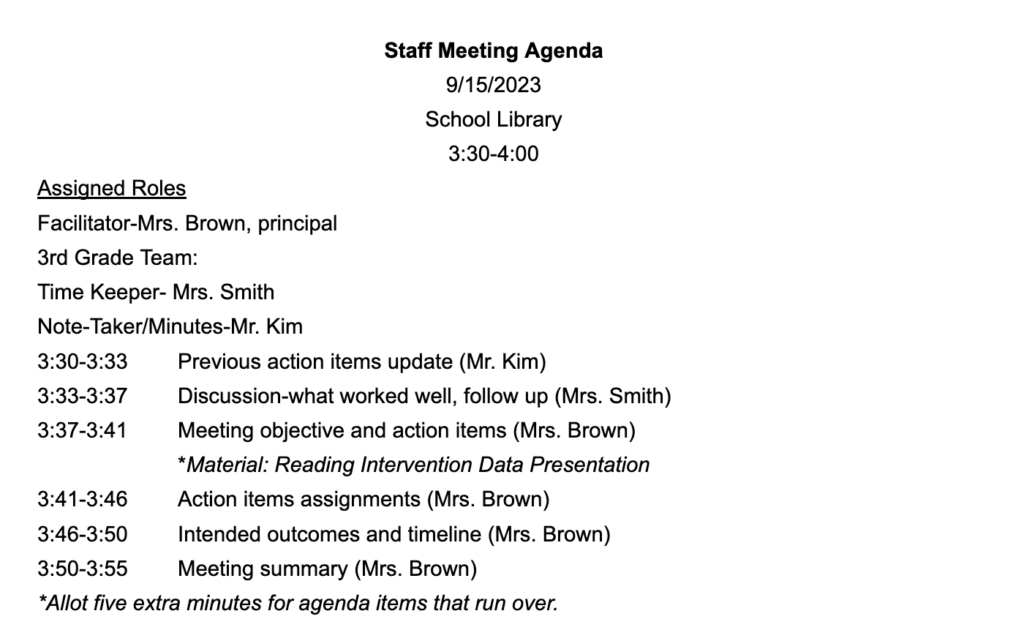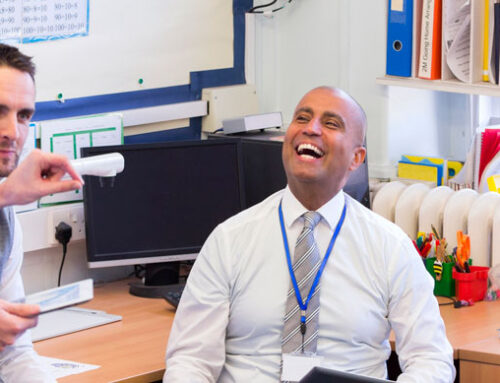Imagine the smiles, sighs of relief, and appreciation when faculty learns about the new 30-minute staff meeting. Some may think that this sounds too good to be true. This blog will show administrators and teachers how to support transitioning to the new, improved 30-minute staff meeting.
Before facilitating a new meeting format, school principals can prepare the 30-minute staff meetings for success by utilizing current norms as the basis for creating new meeting protocols. Check out our previous blog, Meeting Norms for Teachers, to see how your school norms compare. Now is an excellent time to revise, add, or delete outdated norms that will no longer apply. Actually, this might be the perfect objective for the first 30-minute meeting!
For Administrators
Dear Administrators,
This next section is for you! Consider the following steps when developing new meeting protocols and procedures before restructuring your meetings to a 30-minute framework. Initially, you will be responsible for facilitating the staff meetings, but eventually, this role should be shared with staff.
1. Select Meeting Tools
- What programs, applications, or software do you have access to? Do you have the knowledge to choose the tools that best meet the team’s needs?
- Outline what and how you will use specific features.
- Set up teams, folders, drives, applications, and other necessary documents to facilitate the new meetings.
2. Create a Clear Meeting Agenda
- A meaningful agenda should feature a specific objective, rationale, action steps, desired outcomes, and timelines.
- Email attendees a working agenda draft for input several days before the meeting.
- Encourage staff feedback. Be selective in what you add to the agenda. All other ideas will need to be addressed in a small group or individually, outside of the scheduled staff meeting.
- Make necessary agenda updates and give the revised copy to staff before the meeting.
- Include time blocks and the presenting individual for each agenda item.
- Develop a 25-minute agenda for a 30 minute meeting. You’ll be thankful for the extra time, which will help assure that you will dismiss staff on time.
3. Distribute Meeting Materials
- This needs to be done several days BEFORE the meeting so staff has time to read the material! Don’t use staff meetings to present content that someone can view electronically on their own time.
- Consider how you will monitor and enforce this expectation (and others). Brainstorm how to add or expand upon your current meeting norms.
4. Keep Track of the Time
- Attention to time is essential to keep the staff meeting on schedule. It may seem unnecessary to set a timer and strictly adhere to the agenda’s time allotments, but this is key to conducting shortened staff meetings.
- Most importantly, BEGIN and END the meeting on time!
5. Assign Roles
- Every leader has unique strengths. Determine where you can use extra support during meetings and assign staff on a rotating basis. Some example roles include timekeeper, discussion monitor, and note-taker/minutes.
- Consider a little token of appreciation for those performing an assigned role. This can be something as simple as a Hershey’s Kiss or a roll of Smarties.
6. Stick to the Agenda
- Discussions can quickly diverge into unrelated topics, and before you know it, the agenda is no longer running the meeting, and it has taken on a new life of its own. You will need to decide how to handle off-topic comments – remember the goal is a 30 minute meeting.
- The parking lot technique can support established discussion protocols and productivity. When someone shares an off-topic comment, the designated meeting monitor follows your sign to record the person’s name and idea on a sticky note and post it on a board. After the meeting, you can review each note and decide how to acknowledge everyone’s contributions.
7. Come Prepared
- Create a pre-meeting checklist. Some items include agenda copies, meeting handouts, technology devices and set-up, sticky notes, and a timer. This checklist can be shared with future meeting facilitators too!
- Dependence on technology can be daunting. Test that everything is in working order before the meeting. A few technological snafus and your session is highjacked.
8. Encourage Feedback
- Ask staff to reflect on the new meeting format and share their thoughts with you.
- Use this feedback to make any necessary adjustments.
- Recognize common challenges with the different levels of implementation and stay committed to its course.
For Teachers
You have the power to make or break the success of the 30-minute staff meeting. Your feelings about implementing something new may not be the most positive, but rest assured that the tradeoff is the precious commodity of time-the time to spend doing what you choose. So, let’s do what we can to unify colleagues and bring new meaning to staff meetings.
1. Respect Time
- If the meeting starts at 3:30, be in attendance and ready at 3:30, not walking into the room at 3:30. Once you arrive, stay. There is a better time to run an errand, chat with a colleague, or make copies.
- Pay close attention to any time allotments included on the agenda.
2. Come Prepared
- Have you viewed the agenda and any other provided materials? Remember the rationale for this expectation. Sitting through presentations wastes precious time, so when the material is considered beforehand, time can be spent in discussion.
- Complete assigned action items and bring supporting documents.
3. Focus Your Attention
- We’ve heard ourselves repeatedly tell our students to focus. So let’s model good behavior like you would in your classroom!
- Put away cell phones and set them to silent or do not disturb.
- Keep distractions like student papers, lesson plans, and other paperwork in your classroom. The meeting’s fast pace will not allow for old habits to continue. On a positive note: You have a half hour that you never had before-do it then!
4. Meaningful Discussion Contributions
- Have you reviewed the material, and are you prepared to discuss it at the meeting? Annotate and highlight sections that stand out and that you can share with colleagues.
- Support action items by meeting assigned due dates or volunteering for a task.
5. Stay on Topic
- If an item of interest is not on the agenda, don’t try incorporating it into the discussion. Speak with the principal at a later time.
- Read the after-meeting summary, paying close attention to any assigned responsibilities and their due dates.
- Familiarize and utilize yourself with the adopted tools you will need to use. While it is extra work up front, it will ultimately support timely communication and practical use of time.
Now that administrators and teachers understand the 30-minute staff meeting layout and protocols let’s look at an example 30-minute meeting agenda.
Please note that various meeting formats and templates are available. Choosing one that meets the needs of your school and staff is essential.
Sample Staff Meeting Agenda

Concluding Ideas
Some may still believe that reducing the time of staff meetings isn’t possible in today’s complex educational climate. Restructuring how they operate is a crucial step. So, let’s say goodbye to those frustrating, time-consuming meetings where accomplishments are minimal and members leave disgruntled. A 30 minute meeting is a good place to start!
Communication and collaboration among staff members are essential components of effective schools and a pivotal part of student’s academic and social success. The nature of our education setting limits the time that staff has to collaborate. While a shortened staff meeting is not the answer to every problem, it can catalyze a changed mindset, member investment, and improved student outcomes.
Be bold, be brave, be responsive. Let this year be the year you gift yourself and your teachers with a most coveted commodity: time. You can do it!






